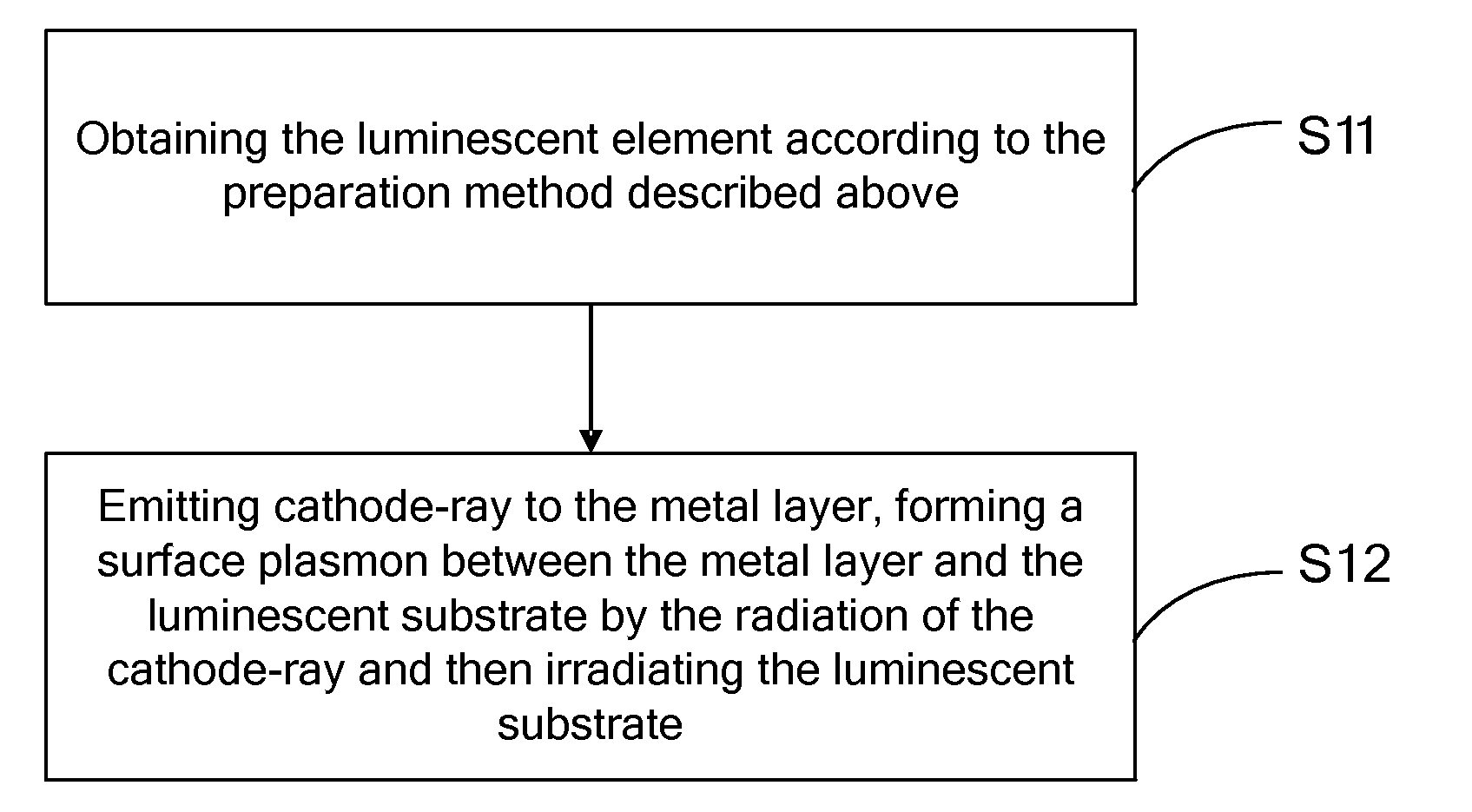Luminescent element, preparation method thereof and luminescence method
a technology of luminescent elements and luminescent substrates, applied in the field of luminescent materials, can solve the problems of limiting the application of field emission devices, especially illumination, and low luminous efficiency, and achieve the effects of high internal quantum efficiency of luminescent substrates, low efficiency of luminescent materials, and high spontaneous emission of luminescent substrates
- Summary
- Abstract
- Description
- Claims
- Application Information
AI Technical Summary
Benefits of technology
Problems solved by technology
Method used
Image
Examples
example 1
[0037]Phosphor with a composition of Zn2SiO4:Mn and glass powder are mixed in accordance with the mass ratio 1:4, and melted to obtain a luminescent glass doped with luminescent materials with the composition of Zn2SiO4:Mn. The glass powder has a chemical composition of 20Na2O-20BaO-30B2O3-30SiO2. A silver layer with a thickness of 2 nm is deposited on a surface of the luminescent glass via a magnetron sputtering equipment. The luminescent glass and the silver layer are annealed at a temperature of 300° C. for half an hour in vacuum with the vacuum degree −3 Pa and cooled to ambient temperature, thus a luminescent element is obtained.
[0038]Spectrum of the luminescent element obtained above is tested. The prepared luminescent element is bombarded by cathode-ray from an electron gun, and the electron beam penetrates the metal layer and irradiates the luminescent glass doped with Zn2SiO4:Mn, thus an emission spectrum shown in FIG. 4 is obtained. As shown in FIG. 4, luminescent material...
example 2
[0040]Phosphor with a composition of Zn2SiO4:Mn and glass powder are mixed in accordance with the mass ratio 1:19, and melted to obtain a luminescent glass doped with luminescent materials with the composition of Zn2SiO4:Mn. The glass powder has a chemical composition of 20Na2O-20BaO-30B2O3-30SiO2. A gold layer with a thickness of 0.5 nm is deposited on a surface of the luminescent glass via a magnetron sputtering equipment. The luminescent glass and the gold layer are annealed at a temperature of 200° C. for an hour in vacuum with the vacuum degree −3 Pa and cooled to ambient temperature, thus a luminescent element is obtained.
example 3
[0041]Phosphor with a composition of Zn2SiO4:Mn and glass powder are mixed in accordance with the mass ratio 7:13, and melted to obtain a luminescent glass doped with luminescent materials with the composition of Zn2SiO4:Mn. The glass powder has a chemical composition of 20Na2O-20BaO-30B2O3-30SiO2. A aluminum layer with a thickness of 200 nm is deposited on a surface of the luminescent glass via a magnetron sputtering equipment. The luminescent glass and the aluminum layer are annealed at a temperature of 500° C. for five hours in vacuum with the vacuum degree −3 Pa and cooled to ambient temperature, thus a luminescent element is obtained.
PUM
| Property | Measurement | Unit |
|---|---|---|
| thickness | aaaaa | aaaaa |
| temperature | aaaaa | aaaaa |
| operating temperature | aaaaa | aaaaa |
Abstract
Description
Claims
Application Information
 Login to View More
Login to View More - R&D
- Intellectual Property
- Life Sciences
- Materials
- Tech Scout
- Unparalleled Data Quality
- Higher Quality Content
- 60% Fewer Hallucinations
Browse by: Latest US Patents, China's latest patents, Technical Efficacy Thesaurus, Application Domain, Technology Topic, Popular Technical Reports.
© 2025 PatSnap. All rights reserved.Legal|Privacy policy|Modern Slavery Act Transparency Statement|Sitemap|About US| Contact US: help@patsnap.com



